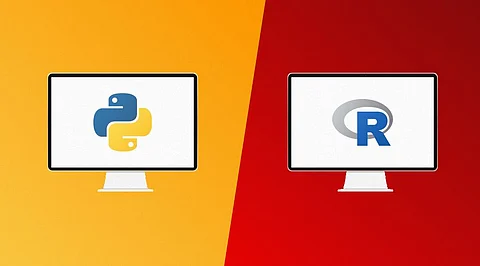

For years, the comparison between Python and R has been a hot topic in industry circles. It's never been easy to choose the ideal one between the two languages for data processing. Statistics defining the significance of the two languages have also changed and shifted in recent years. As a result, it's more accurate to conclude that it's up to the data scientist to choose between these two languages, based on their needs, costs, and widely used resources in the field/project they're working on.
R is an open-source programming language used primarily by statisticians and data engineers to create various algorithms and techniques for statistical modelling and data analysis. In August of 1993, it first appeared on the scene. R has a large number of built-in libraries that include a broad range of statistical and graphical methods, such as regression analysis, statistical tests, classification models, clustering, and time-series analysis. There are numerous packages that assist with exploratory data analysis, simple data exploration, and data visualization in the form of graphs. It has the potential to generate some powerful charts and dashboard-quality graphs to display and track a corporation's monthly revenue or benefit. The R language is supported by the R Studio framework, which aids in the development and execution of R codes and packages.
Python is a multi-paradigm language developed in 1991by Guido van Rossum. It's useful for web creation, software development, and system scripting, among other things. It can be used on a variety of platforms. It enables you to build data sets and SQL tables for use in your code. Python also organizes data and code into objects and provides a number of useful resources. It also has a high level of compatibility, which means it can run the code on a multitude of formats without having to recompile it. This means that you are making the best use of your time. Python can be used for a variety of purposes thanks to its extensive library. It is one of the top ten most widely used programming languages.
It depends on what you want to do to choose between R and Python.
Python is for general-purpose programming and R is for statistical analysis. R is used for a narrower purpose, while Python is used to write applications for a broader range of application areas.
Where a data processing task necessitates standalone computation or analysis on separate servers, R is used. When data analysis activities need to be incorporated with web applications or statistics code needs to be introduced into a production database, Python is a good choice.
Python excels at data manipulation and repetitive tasks, while R excels at ad-hoc analysis and dataset exploration.
Python is a popular and flexible programming language that programmers can use to accomplish a wide range of computer science tasks. Learning Python will help you build a powerful data science toolkit and it's a programming language that even non-programmers can pick up quickly.
R, on the other hand, is a common data science programming environment that is built specifically for data analysis. If you want to advance in your data science profession, you'll need to learn R.
Learning both tools and applying them for their unique goals can only help you develop as a data scientist. Any data scientist at the peak of their game possesses versatility and durability. The debate between Python and R limits you to one programming language. You should look beyond it and appreciate all methods for their distinct advantages. As a data scientist, using more resources will only help you improve.
Join our WhatsApp Channel to get the latest news, exclusives and videos on WhatsApp
_____________
Disclaimer: Analytics Insight does not provide financial advice or guidance. Also note that the cryptocurrencies mentioned/listed on the website could potentially be scams, i.e. designed to induce you to invest financial resources that may be lost forever and not be recoverable once investments are made. You are responsible for conducting your own research (DYOR) before making any investments. Read more here.
